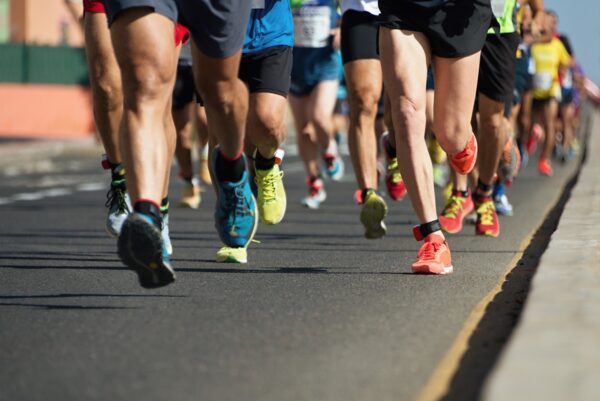
It’s no secret that staying physically active is good for you. It helps keep both the body and the mind healthy. But getting enough exercise can be challenging for many people living with vision loss. With the right adaptations, however, most people can find ways to work up a good sweat. You just need to find the activity or activities that are right for you.
For Rebecca Arrowood of Greenville, a member of the Council’s Board of Directors, the right activity turned out to be running. Rebecca has now been running for about ten years. She grew up playing soccer, but as her vision declined and that sport became less feasible, she felt she needed to find another way to remain physically active. So she decided to train for a half marathon.
“I found that I really enjoyed it,” Rebecca says. “And then the following year, I was going to be turning 26, so I decided I’m going to do a marathon. You know, 26 years, 26 miles. So that’s kind of how I got into it.”
With that first marathon under her belt, Rebecca kept at it. Now she is training for the New York City Marathon, which takes place in November.
One of the keys to running safely with significant vision loss is to work with a sighted guide. With a guide, even individuals with no functional vision can run. While there is formal training available for sighted guides, many runners with vision loss prefer to recruit their own from among their circle of friends. That’s what Rebecca typically does.
“Obviously it depends on the level of vision loss, but mine got to the point where if I’m going to run in an unfamiliar area, I definitely need a sighted running guide,” Rebecca says. “It can be people from anywhere, they don’t have to be experienced. I teach them everything they need to know. Some people will use a hand tether, but I like my hands to be free so I’m not having to run in sync with someone. So it’s a lot of verbal cues, like curb up, curb down, bumpy road, we’re gonna go right, we’re gonna go left, things like that.”
Naturally, running with a sighted guide takes some getting used to, and it requires a certain level of trust. It helps to understand that realistically, stumbles will happen, even with the best guide in the world. But for Rebecca and thousands of others with vision loss who like to run, it’s more than worth the risk.
“Sure, I have fallen a couple of times,” Rebecca says. “If you look at it from the perspective that you’re trying something new, just like if you’re going to start skiing or snowboarding, you’re probably gonna fall at some point. That’s just kind of part of it.”
In other words, the rewards far outweigh the risks. Studies regularly show that getting routine exercise is often an issue for people with vision loss, and that has an impact on physical well-being. But it’s not just about heart health. Staying active is also important for mental health. And participating in physical activities with others helps address the chronic loneliness and isolation that are common among this population.
So what’s Rebecca’s advice for someone with vision loss who’s thinking about taking that first step, so to speak?
“Just jump in and do it,” she says. But start slowly. “Maybe start out indoors on a treadmill…. Then maybe just find someone that you’re able to run with, and go find a track, and start running around the track together to help build that level of comfort and trust as opposed to starting out on a bumpy sidewalk.”
And then by a decade from now, maybe you too will be training for the New York City Marathon. Or perhaps you will just have a fun hobby that makes you feel better physically, mentally and emotionally.

